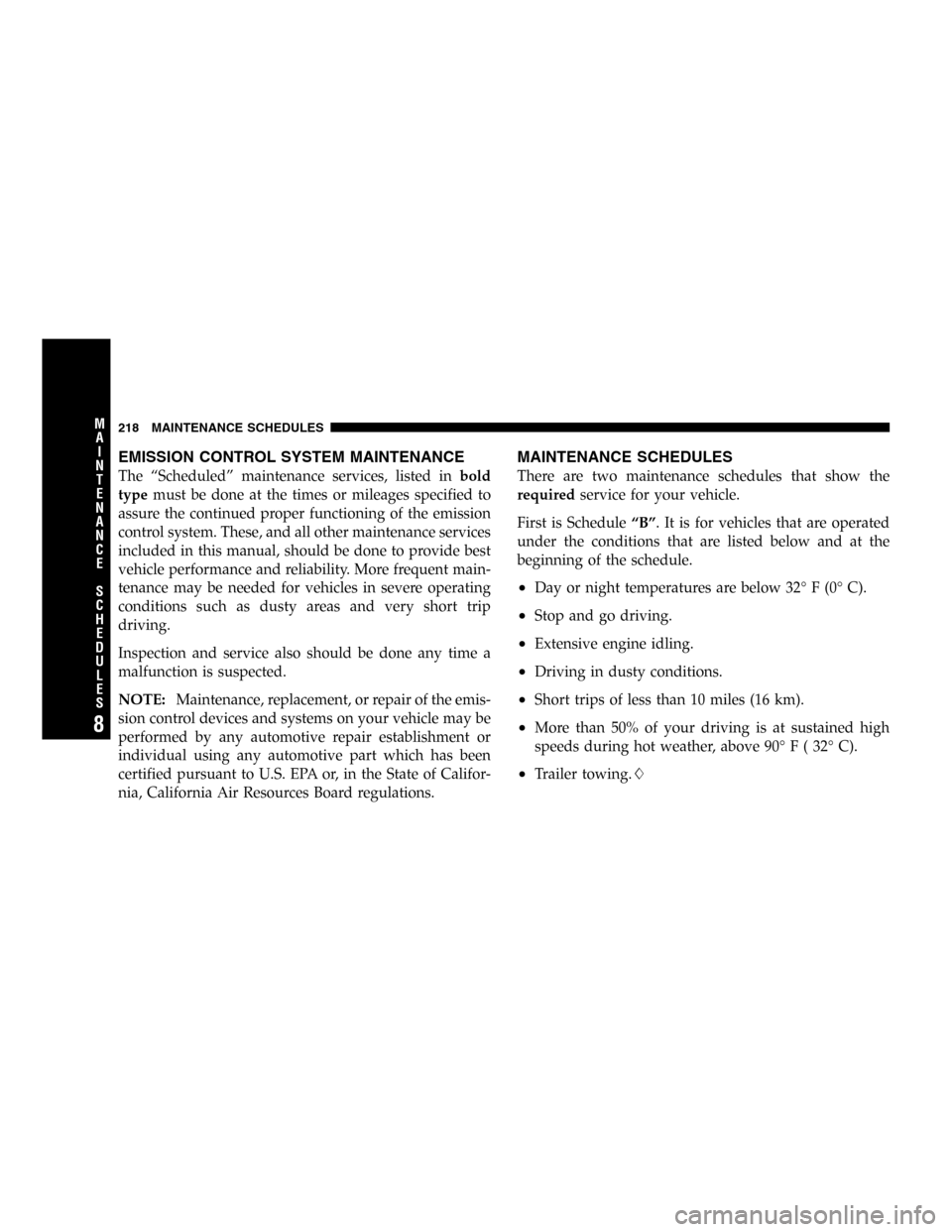Page 192 of 264

fluid level up to the requirements described on the brake
fluid reservoir. With disc brakes, fluid level can be
expected to fall as the brake pads wear. However, low
fluid level may be caused by a leak and a checkup may be
needed. Use only the manufacturer’s recommended
brake fluid. Refer to the Recommended Fluids, Lubri-
cants and Genuine Parts section for the correct fluid type.
Mopar Brake Fluid is fluid of this quality and is recom-
mended to provide best brake performance. Use of a
brake fluid that may have a lower initial boiling point or
unidentified as to specification, may result in sudden
brake failure during hard prolonged braking.
Use only brake fluid that has been in a tightly closed
container to avoid contamination from foreign matter.Hydraulic Clutch
The fluid in the clutch master cylinder should be checked
when performing other under hood services. To check
the fluid level, remove the reservoir cap. If necessary, add
fluid to the reservoir. Use only the manufacturer’s rec-
ommended brake fluid. Refer to the Recommended Flu-
ids, Lubricants and Genuine Parts section for the correct
fluid type. Mopar brake fluid is fluid of this quality and
is recommended to provide best brake performance.
Make sure that the fluid has been stored in a tightly
closed container to avoid contamination with dirt or
moisture. Do Not Overfill. Overfilling can cause clutch
release problems as the clutch wears. A low fluid level
may indicate a leak, in which case, hydraulic clutch
linkage replacement may be required. The fluid level in
the reservoir will rise as the clutch wears - Do Not
Remove Fluid.
Do not allow petroleum base fluid to contaminate the
brake fluid—seal damage will result.
192 MAINTAINING YOUR VEHICLE
Page 193 of 264

Transmission
Lubricant Selection
Refer to the Recommended Fluids, Lubricants and Genu-
ine Parts section for correct fluid type.
CAUTION!
Using a transmission fluid other than the manufac-
turer’s recommended fluid may cause deterioration
in transmission shift quality. Refer to the Recom-
mended Fluids, Lubricants and Genuine Parts sec-
tion for correct fluid type.
Fluid Level Check
The fluid in the transmission should be checked when-
ever other underhood services are done. Check the fluid
level by removing the fill plug located on the left side ofthe transmission. The fluid level should be at the bottom
of the fill hole. Add fluid, if necessary, to maintain the
proper level.
Frequency of Fluid Change
Under normal operating conditions, the fluid installed at
the factory will give satisfactory lubrication for the life of
the vehicle. If the vehicle is operated under severe
conditions, change the fluid as specified in Maintenance
ScheduleB. If contaminated with water, the fluid should
be changed immediately.
Rear Axle
Fluid Level Check
Every 12 months or 6,000 miles (10 000 km) the exterior of
the axle should be checked for evidence of gear oil
leakage. This check should be made with the vehicle in a
level position, supported by the suspension, on an axle
and wheel type hoist, or on the ground. The axle fluid
MAINTAINING YOUR VEHICLE 193
7
Page 203 of 264

the vehicle is not going to be driven in the next 3
weeks, follow the battery recharge procedure in the
Service Manual, then disconnect the battery at the
negative terminal or use the save feature described in
Maintaining your Vehicle section under the Mainte-
nance Procedures sub-section, within Maintenance-
Free Battery.
CAUTION!
Use care when disconnecting the remote positive
cable. It is connected to the battery and can short out
to any metal on the vehicle. Always tape or wrap the
exposed cable end to prevent electrical shorts.
•Disconnecting the battery causes the engine control
system to lose memory of some“learned”functions,
unless using the Battery Save feature described inMaintaining your Vehicle section under the Mainte-
nance Procedures sub-section, within Maintenance-
Free Battery. The engine may run rough when first
started after a battery disconnect until the control
module“relearns”these functions.
Check the battery every 4 to 6 weeks to ensure that the
voltage is above 12.40. Voltage will drop more rapidly
in hot temperatures. If battery voltage drops below
12.40, follow the battery recharge procedure in the
Service Manual.
•Check that the radiator coolant level of protection is to
at least -20°F (-29°C).
•Block the wheels. Do not apply the Parking Brake.
•Make sure that all tires are inflated to the optimum
pressure, (29 PSI).
MAINTAINING YOUR VEHICLE 203
7
Page 204 of 264

•Cut blocks of plywood about the same size of the tires.
Cover each block with indoor/outdoor carpeting and
place them between the tires and concrete. This will
prevent tire flat spotting.
•For long term storage, remove the tires and put the
vehicle up on blocks. Stack the tires on plywood and
cover with a tarp to prevent flat spotting.
•Move the wiper blades away from the windshield.
NOTE:To help prevent the battery from discharging
during shorter periods of inactivity, perform the follow-
ing:
1. Make sure that the trunk, hood, doors, windows and
convertible top are completely closed.
2. Make sure that remote transmitter is operating and
that the battery is good.3. Make sure that the hood, trunk and door switches are
in adjustment. Perform the quick system check which
follows.
Use the remote transmitter to set the alarm. If the alarm
SET light comes on and flashes, the system is operating
properly. If not, there is a problem with a switch or the
system. See your dealer for service.REPLACEMENT BULBS
Interior Light Bulbs
Message Center Indicators.................. 103
Cluster................................ 103
Gauge Pack............................ 103
Heater Control........................... 37
Interior Light..........................212–2
Courtesy Footwell Lights................... 194
204 MAINTAINING YOUR VEHICLE
Page 205 of 264
Exterior Light Bulbs
Headlight-Low/High Beam.... Serviced at dealer only
Aux. Headlight-High Beam.........(HB3A) 9005XS
Front Park/Turn......................3157AK
Fog Light.......................(H10 U) 9145
Front Sidemarker.......................2886X
Center Stop Light.......... 16LED(not serviceable)
Rear Tail/Stop..........................3157
Rear Tail Light.......................... 194
Rear Marker Light........................ 194
Back up Light..........................3157
Rear Turn Light.......................3457AK
License................................ 168
NOTE:You will note that upon turning the (HID) High
Intensity Discharge Headlamp Bulbs on, there is a blue
hue to the lamps. This diminishes and becomes more
white after approximately 10 seconds as the system
charges.
EXTERIOR LIGHT BULB SERVICE
Headlight, Parking, Front Park, Turn Signal, Front
Sidemarker and Front Fog Light Removal
1. Remove the splash shield.
MAINTAINING YOUR VEHICLE 205
7
Page 207 of 264
High Intensity Discharge Headlights (HID)
The headlights are a type of high voltage discharge tube.
High voltage can remain in the circuit even with the
headlight switch off and the key removed.Because of
this, you should not attempt to service a headlight bulb
yourself. If a headlight bulb fails, take your vehicle to
an authorized dealer for service.
WARNING!
A transient high tension occurs at the bulb sockets of
High Intensity Discharge (HID) headlights when the
headlight switch is turned ON. It may cause serious
electrical shock or electrocution if not serviced prop-
erly. See your authorized dealer for service.
NOTE:If High Intensity Discharge (HID) lights are not
working, recycle the headlight switch 4 times to see if it
will restrike.
Tail, Tail/Stop, and Marker Lamp Bulb
Replacement
1. Open the trunk. Remove two access panel fasteners.
Remove the access panel.
MAINTAINING YOUR VEHICLE 207
7
Page 218 of 264

EMISSION CONTROL SYSTEM MAINTENANCE
The“Scheduled”maintenance services, listed inbold
typemust be done at the times or mileages specified to
assure the continued proper functioning of the emission
control system. These, and all other maintenance services
included in this manual, should be done to provide best
vehicle performance and reliability. More frequent main-
tenance may be needed for vehicles in severe operating
conditions such as dusty areas and very short trip
driving.
Inspection and service also should be done any time a
malfunction is suspected.
NOTE:Maintenance, replacement, or repair of the emis-
sion control devices and systems on your vehicle may be
performed by any automotive repair establishment or
individual using any automotive part which has been
certified pursuant to U.S. EPA or, in the State of Califor-
nia, California Air Resources Board regulations.
MAINTENANCE SCHEDULES
There are two maintenance schedules that show the
requiredservice for your vehicle.
First is Schedule“B”. It is for vehicles that are operated
under the conditions that are listed below and at the
beginning of the schedule.
•Day or night temperatures are below 32°F(0°C).
•Stop and go driving.
•Extensive engine idling.
•Driving in dusty conditions.
•Short trips of less than 10 miles (16 km).
•More than 50% of your driving is at sustained high
speeds during hot weather, above 90°F(32°C).
•Trailer towing.�
218 MAINTENANCE SCHEDULES
8
M
A
I
N
T
E
N
A
N
C
E
S
C
H
E
D
U
L
E
S
Page 219 of 264

•Taxi, police, or delivery service (commercial ser-
vice).�
•Off-road or desert operation.
•If equipped for and operating with E-85 (ethanol)
fuel.
NOTE:IfANYof these apply to you then change your
engine oil every 3,000 miles (5,000 km) or 3 months,
whichever comes first and follow schedule B of the
“Maintenance Schedules”section of this manual.
NOTE:IfANYof these apply to you then flush and
replace the engine coolant every 102,000 miles (164,000
km) or 60 months, whichever comes first, and follow
schedule B of the�Maintenance Schedules�section of this
manual.
NOTE:Most vehicles are operated under the conditions
listed for Schedule�B�.Second is Schedule“A”. It is for vehicles that are not
operated under any of the conditions listed under Sched-
ule�B�.
Use the schedule that best describes your driving condi-
tions. Where time and mileage are listed, follow the
interval that occurs first.
NOTE: Under no circumstances should oil change
intervals exceed 6 months or 6,000 miles, whichever
comes first.
CAUTION!
Failure to perform the required maintenance items
may result in damage to the vehicle.
MAINTENANCE SCHEDULES 219
8
M
A
I
N
T
E
N
A
N
C
E
S
C
H
E
D
U
L
E
S